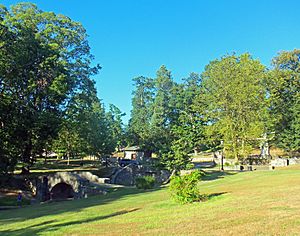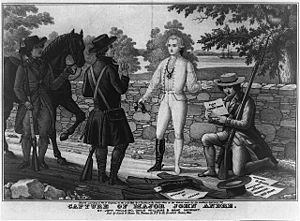Patriot's Park facts for kids
Quick facts for kids Patriot's Park |
|
|---|---|

Decorative features of park, including Captors' Monument at right, 2012
|
|
| Lua error in Module:Location_map at line 420: attempt to index field 'wikibase' (a nil value). | |
| Type | Public |
| Location | Sleepy Hollow and Tarrytown, NY, USA |
| Nearest city | White Plains |
| Area | 4 acres (1.6 ha) |
| Created | 1853 |
| Operated by | Villages of Sleepy Hollow and Tarrytown |
|
Patriot's Park
|
|
| Architect | Carrere & Hastings |
| NRHP reference No. | 82003415 |
| Added to NRHP | June 14, 1982 |
Patriot's Park (first called Brookside Park) is a special place in New York State. It sits on U.S. Route 9, right where the towns of Tarrytown and Sleepy Hollow meet. This four-acre (1.6-hectare) park has walking paths and several important monuments. In 1982, it was added to the National Register of Historic Places, which means it's a historically important site.
Contents
What Happened at Patriot's Park?
Patriot's Park is famous for a key event during the Revolutionary War. In 1780, a British Army officer named Major John André was captured here. He was dressed in regular clothes, trying to hide. Three American militiamen, who were Patriots, caught him.
They searched him and found secret papers. These papers showed that André was working with Benedict Arnold, a high-ranking American officer. Arnold was secretly planning to betray the American army. After a military trial, André was executed. Arnold then switched sides to the British. He lived the rest of his life in England.
In 1853, a memorial was built at this spot. The land for the memorial was given by local African American families. This was one of the first monuments to honor an event from the Revolutionary War. Later, the area grew and became part of Brookside Park. This park was designed in the late 1800s. It was even home to two girls' schools, one of which famous actress Lauren Bacall attended. In the mid-1900s, it became Patriot's Park. Most of the old buildings were taken down, except for a small gatehouse.
Exploring the Park Grounds
Patriot's Park covers four acres (1.6 hectares). It is located between North Broadway (Route 9) on the east and North Washington Street on the west. College Avenue is to the north. The park has two small hills, which slope down towards the nearby Hudson River.
A small stream called Andre Brook runs through the park. This brook also marks the boundary between Tarrytown (to the south) and Sleepy Hollow (to the north). The park has many tall, old trees that offer plenty of shade.
Walking Paths and Entrances
The park's main feature is an oval-shaped walkway. You can enter the walkway from the north, east, and west. There are also short paths leading to a basketball court and to North Broadway. The main entrance is on the west side. It has two large gateposts made of rough granite blocks. Stone walls run along the sidewalks, creating raised areas with granite steps leading to the walkway.
The Gatehouse and Monuments
In the northern part of the park, there is a stone gatehouse. It has stone walls and a sloped roof. Its entrance is on the west side, and it has one window on the north.
South of the west entrance is the Captors' Monument. It is surrounded by a square iron fence. This monument has a bronze statue of John Paulding on top of two stone bases. Paulding was one of the men who captured Major André. The lower base is made of white marble. It has a bronze plaque showing André's capture. South of this monument, you can also find a more modern statue of Christopher Columbus.
Andre Brook and Bridges
Near the entrance, stone steps and a sloped path lead down to a basin. Here, Andre Brook flows out from under North Broadway. The brook then flows over a small dam and down a concrete channel. A stone path runs along the south bank of the brook.
You'll find a small stone footbridge over the brook. Further down, the brook flows under a heavier drive bridge. After that, it goes into another culvert under North Washington Avenue.
The park also has two playgrounds. A smaller, older one is in the northwest corner. A newer, larger one is in the southwest, close to the library. Decorative lamps light the paths, and benches are placed around the park for visitors to rest.
History of Patriot's Park
The park's history is deeply connected to the capture of Major André during the Revolutionary War. After the monument was built in the mid-1800s, the area was developed with homes and schools. Over time, it became the park we see today, with several changes and improvements.
1780: Major André's Capture Explained
In 1780, five years into the Revolutionary War, the area around Tarrytown was called "Neutral Ground." This was a 30-mile-wide area between the British army in New York City and the American army to the north. Groups of armed bandits, called Cow-boys (who supported the British) and Skinners (who supported the Americans), roamed the area.
On September 24, 1780, three young men—John Paulding, Isaac Van Wart, and David Williams—were waiting along the road in Tarrytown. They were Skinners, hoping to catch some Cow-boys. A rider approached them. It was Major John André of the British Army. He was returning from a secret meeting at West Point. There, he had been negotiating with General Benedict Arnold about Arnold's plan to surrender West Point to the British.
Paulding had recently escaped from British capture. He was wearing a coat he had taken from a Hessian soldier (German soldiers hired by the British). This made André think the three men were Cow-boys. André even showed them a pass signed by Arnold. But the three men searched André. They found secret papers hidden in his boots. These papers included his letters with Arnold and maps of West Point's defenses.
Paulding, who could read, quickly realized André was a spy. Williams asked André for money, but Paulding refused any bribe. He said that even 10,000 guineas (a type of old British coin) would not be enough to let André go.
André was then handed over to the American army. He was taken to Tappan and held prisoner. After a military trial, he was found guilty of being a spy. George Washington himself ordered André to be hanged. If André had successfully delivered the information to the British, they could have taken control of the Hudson River. This would have cut off New England from the other American colonies, possibly changing the outcome of the war.
Benedict Arnold found out about André's arrest and escaped to the British with his family. He served in the British Army and later moved to England. Paulding, Van Wart, and Williams were rewarded for their actions. The Continental Congress gave them lifetime pensions and the Fidelity Medallion, which was one of the first U.S. military awards. The state of New York also gave them farms. Later, three counties in Ohio were named after them. The elementary school near the park is also named after Paulding.
1853–1942: From Homes to Schools
After David Williams, the last of the three captors, passed away in 1831, people wanted to build a monument. In 1852, the Monument Association to the Captors of Major André was finally formed. They were able to make the monument a reality. A local free African American couple, William and Mary Taylor, donated their land for the monument. The first stone was laid on July 4, 1853. Important people like Alexander Hamilton's son, James, and New York's governor, Horatio Seymour, attended the ceremony. The lower part of the monument was built from marble from nearby Sing Sing (now Ossining). It was first topped with a tall, pointed stone called an obelisk.
In 1880, on the 100th anniversary of the capture, the monument was made larger and rededicated. A huge crowd of 70,000 people came to the event. The obelisk was replaced with the current concrete block, and a statue of Paulding was added.
Around that time, there were three houses across North Broadway. They were taken down for a plan in 1892 to make the monument part of a new neighborhood called Brookside Park. The famous architects Carrère and Hastings designed eight beautiful cottages and a stone gatehouse. They also planned the park's landscaping. By the end of 1892, all the buildings were finished.
In 1896, the property was sold. In 1911, the Knox School for Girls rented the buildings. They named the cottages after roses. By the end of the decade, the school needed more space and moved. In 1920, another girls' school, Highland Manor, moved in.
One of the students at Highland Manor was Lauren Bacall, who later became a very successful actress. In 1942, Highland Manor also moved to a larger campus. Two local women bought the park. They had all but one of the neglected cottages taken down. Then, they donated the property to the two villages. At that time, it was renamed Patriot's Park.
1943–Present: The Park Today
After World War II ended, three local garden clubs formed a group to help restore the park. They followed a plan to improve the area. In 1949, the places where the old houses stood were filled in and planted with new greenery. Over the next six years, more improvements were made. New paved paths were created. Dead trees were replaced with younger dogwood trees. The brook's channel was lined with concrete. All the stone work was repaired.
The last remaining house from Brookside Park was used for storage and a gym. It was taken down around 1970. The gatehouse is the only building left from that original development. As of 1982, the villages of Tarrytown and North Tarrytown (which is now Sleepy Hollow) each spent money every year to maintain the park.
Images for kids







